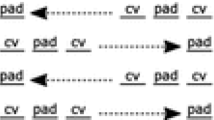Abstract
The standard abstract model for analyzing DNA self-assembly, aTAM, assumes that single tiles attach one by one to a larger structure. In practice, tiles may attach to each other forming structures called polyominoes and then attach to the assembly using bonds from multiple tiles. Such polyominoes may cause errors in systems designed with only aTAM in mind. In this paper, we first present a formal definition of when one tile system is a “block replacement” of another. Then we present a block replacement scheme for making any system that admits non-trivial block replacement polyomino-safe. In addition, we present a smaller block replacement scheme that makes the Chinese Remainder counter polyomino-safe and prove that the question of whether a system is polyomino-safe (or other similar properties) is undecidable. Finally, we show that applying our polyomino-safe system produces self-healing systems when applied to most self-healing systems.




Similar content being viewed by others
References
Adleman L, Cheng Q, Goel A, Huang M (2001) Running time and program size for self-assembled squares. In: ACM symposium on theory of computing, pp 740–748
Aggarwal G, Cheng Q, Goldwasser M, Kao MY, Moisset de Espanes P, Schweller R (2005) Complexities for generalized models of self-assembly. SIAM J Comput 34:1493–1515
Barish R, Rothemund P, Winfree E (2005) Two computational primitives for algorithmic self-assembly: copying and counting. Nano Lett 5:2586–2592
Baryshnikov Y, Coffman E, Momcilovic P (2004) DNA-based computation times. In: Proceedings of the tenth international meeting on DNA based computers, Milano, Italy
Chen H, Goel A (2005) Error free self-assembly using error prone tiles. In: Ferretti C, Mauri G, Zandron C (eds) DNA computing 10, LNCS vol 3384. Berlin, Springer-Verlag, pp 62–75
Chen H, Cheng Q, Goel A, Huang M, Moisset P (2004) Invadable self-assembly: Combining robustness with efficiency. ACM-SIAM symposium on discrete algorithms (SODA)
Cheng Q, Goel A, Moisset P (2004) Optimal self-assembly of counters at temperature two. In: Proceedings of the first conference on foundations of nanoscience: self-assembled architectures and devices
Chen H, Goel A, Luhrs C, Winfree E (2007) Self-assembling tile systems that heal from small fragments. DNA 13:30–45
Chen H, Goel A, Luhrs C (2008) Dimension augmentation and combinatorial criteria for efficient error-resistant DNA self-assembly. In: Symposium on discrete algorithms, pp 409–418
Demaine E, Demaine M, Fekete S, Ishaque M, Rafalin E, Schweller R, Souvaine D (2007) Staged self-assembly: nanomanufacture of arbitrary shapes with o(1) glues. LNCS vol 4848
Lagoudakis M, LaBean T (2000) 2-D DNA self-assembly for satisfiability. In: Winfree E, Gifford DK (eds) DNA based computers V, vol 54 of DIMACS. Providence, American Mathematical Society, pp 141–154
Reif J, Sahu S, Yin P (2005) Compact error-resilient computational DNA tiling assemblies. In: Ferretti C, Mauri G, Zandron C (eds) DNA computing 10, LNCS vol 3384. Berlin, Springer-Verlag, pp 293-307
Rothemund P (2006) Folding DNA to create nanoscale shapes and patterns. Nature 440:297–302
Rothemund P, Winfree E (2000) The program-size complexity of self-assembled squares. In: Symposium on theory of computing (STOC), Portland, Oregon, United States, ACM Press, pp 459–468
Schulman R, Winfree E (2005) Programmable control of nucleation for algorithmic self-assembly. In: Ferretti C, Mauri G, Zandron C (eds) DNA computing 10, LNCS vol 3384. Berlin, Springer-Verlag, pp 319-328. Extended abstract; preprint of the full paper is cond.mat/0607317 on arXiv.org
Sherman W, Seeman N (2004) A precisely controlled DNA biped walking device. Nano Lett 4:1203–1207
Shin JS, Pierce N (2004) A synthetic DNA walker for molecular transport. J Am Chem Soc 126:10834–10835
Soloveichik D, Winfree E (2005) Complexity of compact proofreading for self-assembled patterns. In: DNA Computing 11. Berlin, Springer-Verlag
Tian Y, He Y, Chen Y, Yin P, Mao C (2005) A DNA zyme that walks processively and autonomously along a one-dimensional track. Angew Chem 117:4429–4432
Winfree E (2006) Self-healing tile sets. In: Chen J, Jonoska N, Rozenberg G (eds) Nanotechnology: science and computation. Berlin, Springer-Verlag, pp 55--78
Winfree E (1998) Algorithmic self-assembly of DNA. PhD thesis, California institute of technology, computation and neural systems option
Winfree E, Bekbolatov R (2004) Proofreading tile sets: Error-correction for algorithmic self-assembly. In: Chen J, Reif J (eds) DNA Computing 9. LNCS vol 2943. Berlin, Springer-Verlag, pp 126–144
Winfree E, Yang X, Seeman N (1998a) Universal computation via self-assembly of DNA: Some theory and experiments. In: Landweber LF, Baum EB (eds) DNA Based Computers II, vol 44 of DIMACS. Providence, American Mathematical Society, pp 191–213
Winfree E, Liu F, Wenzler L, Seeman, N (1998b) Design and self-assembly of two-dimensional DNA crystals. Nature 394:539–544
Yin P, Yan H, Daniel X, Turberfield A, Reif J (2004) A unidirectional DNA walker moving autonomously along a linear track. Angew Chem 43:4906–4911
Yurke B, Turberfield A, Mills AP Jr, Simmel FC, Neumann JL (2000) A DNA-fuelled molecular machine made of DNA. Nature 406:605–608
Acknowledgement
This research was supported in part by NSF grants 1104592 and 1097249.
Author information
Authors and Affiliations
Corresponding author
Rights and permissions
About this article
Cite this article
Luhrs, C. Polyomino-safe DNA self-assembly via block replacement. Nat Comput 9, 97–109 (2010). https://doi.org/10.1007/s11047-009-9125-0
Received:
Accepted:
Published:
Issue Date:
DOI: https://doi.org/10.1007/s11047-009-9125-0




